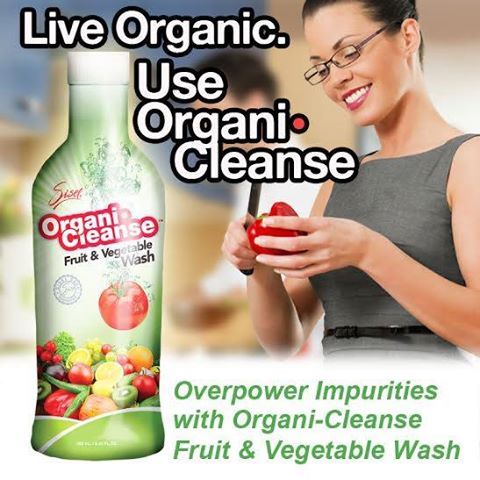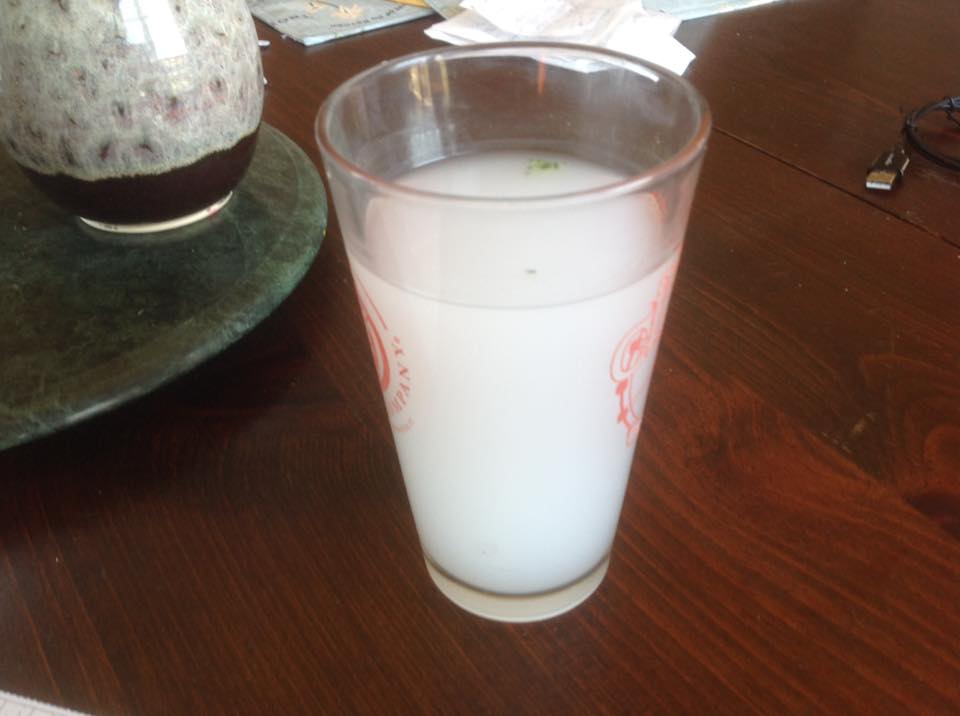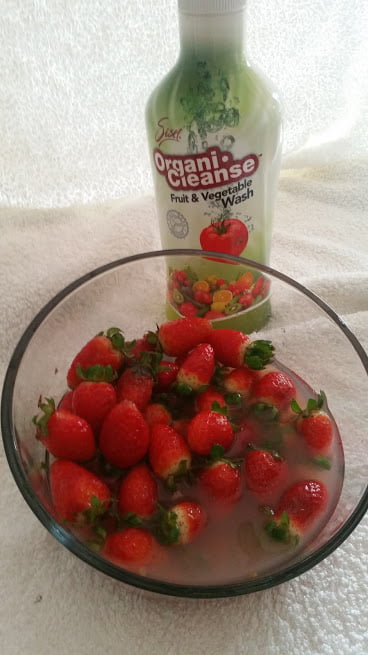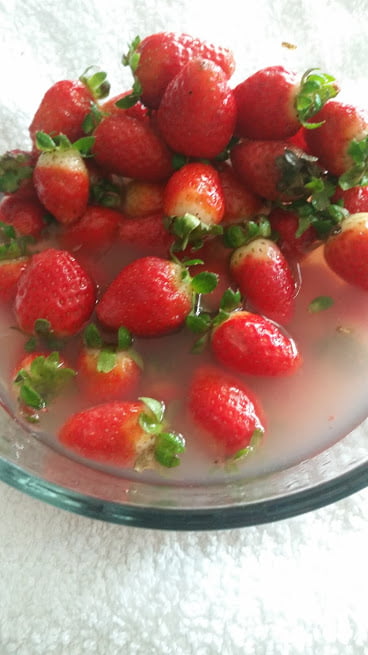How to clean fruit and vegetables from pesticides Sisel’s OrganiCleanse. Look at these amazing results! You won’t believe your eyes! Reduce your exposure to toxins.

How to clean fruit and vegetables from pesticides with Sisel’s OrganiCleanse

Cleaning Fruit and Vegetables removing pesticides
Betsy: Does anybody ever notice when you buy a bag of broccoli, and it says “steam in the bag”, that it doesn’t say “thoroughly washed” anywhere on the bag? Are they assuming you empty the bag, wash the produce, and put it back in?? (I don’t cook it in a plastic bag, I’m just asking because of what the label says). Here’s what the water looked like after a 3-minute soak in our produce wash:
Katie: cloudy not brown curious what chemicals are causing the reaction?
Rob: Looks like a wax.
Katie: I seen it happen with strawberries too would that be a wax?
Rob: Could be.
https://en.wikipedia.org/wiki/Fruit_waxing
Fruit waxing
From Wikipedia, the free encyclopedia
Fruit waxing is the process of covering fruits (and in some cases vegetables) with artificial waxing material. Natural wax is removed first, usually by washing. Waxing materials may be either natural or petroleum-based.
The primary reasons for waxing are to prevent water loss (making up for the removal in washing of the natural waxes in fruits that have them, particularly citrus but also, for example, apples[1]) and thus retard shrinkage and spoilage, and to improve appearance.[2] Dyes may be added to further enhance appearance,[3] and sometimes fungicides.[4] Fruits were waxed to cause fermentation as early as the 12th or the 13th century; commercial producers began waxing citrus to extend shelf life in the 1920s and 1930s. Aesthetics-consumer preference for shiny fruit-has since become the main reason.[1][4] In addition to fruit, some vegetables can usefully be waxed, such as cassava;[5] vegetables commonly waxed include cucumbers, swedes or rutabagas and green tomatoes.[6] A distinction may be made between storage wax, pack-out wax (for immediate sale) and high-shine wax (for optimum attractiveness).[7]
The waxing materials used depend to some extent on regulations in the country of production and/or export; both natural waxes (sugar-cane, carnauba, shellac, orresin)[3] or petroleum-based waxes (usually proprietary formulae)[2] are used. Wax may be applied in a volatile petroleum-based solvent but is now more commonly applied via a water-based emulsion.[4] Blended paraffin waxes applied as an oil or paste are often used on vegetables.[7] Brand names for waxes include Tal-Prolong, Semper-fresh, Frutox, Waxol, Fruit, vegetable kleen, Nipro Fresh[8][9] and Decco Luster.[10]
Betsy: Interesting! I’d still rather wash it all off…could be a fungicide in it, too? And it could be a petroleum-based wax? And why does it not say “washed” on the bag?? What do you all think?
Rob: Washed implies cleaned which perhaps it is not. The waxing could be locking in fungicides, pesticides, etc., which may not be reached until after the wax is gone.

Another great product from Sisel Organi-Cleanse assists to wash away residue from pesticides and herbicides …. Shars pancakes taste so much better !!
Katie: Wow is that the muck and chemicals coming off the strawberries that’s turning the water cloudy?
Trevor: Yes
Sisel’s OrganiCleanse Cleaning your produce is so important.
By Tom Mower April 14 at 10:29am ·
Contaminated fruits and vegetables.
I strongly suggest Sisel’s OrganiCleanse should be used on all produce to clean away and neutralise pesticides and Herbicides on them.
“An ounce of prevention may be well worth a lifetime of damaged health or cancer”.
Strawberries top this year’s list of the produce with the highest level of pesticide residue, according to a new report.
The fruit displaces apples — now ranked second — which headed the “Dirty Dozen” list for the previous five years.
For the report, the group analyzed test results of more than 35,200 samples of fruits and vegetables taken by the U.S. Department of Agriculture and the Food and Drug Administration.
Nearly all of the (non-organic) strawberry samples — at least 98 percent — had detectable pesticide residues, with 47 percent having residues of 10 or more pesticides. Some samples showed residue from 17 different pesticides.
Some of the chemicals found on the strawberries and others have been linked to cancer, reproductive and developmental damage, hormone disruption, and neurological problems, the group reports.
“It is startling to see how heavily strawberries are contaminated with residues of hazardous pesticides, but even more shocking is that these residues don’t violate the weak U.S. laws and regulations on pesticides in food,” “The EPA’s levels of residues allowed on produce are too lax to protect Americans’ health. They should be updated to reflect new research that shows even very small doses of toxic chemicals can be harmful, particularly for young children.”
The EPA says the levels are not harmful to eat. “We perform dietary risk assessments to ensure that all tolerances established for each pesticide are safe. These assessments account for the fact that the diets of infants and children may be quite different from those of adults and that they consume more food for their size than adults,” the agency says on its website.
I say DUH, to the EPA do not “children’s” lives matter? Even though it seems ours do not seem to… to you?
Sisel’s OrganiCleanse for cleaning your produce is so important
Tom Mower April 14
Disturbing New Evidence About What Common Pesticides Can Do to Brains
These fungicides are used on a wide range of crops for defense against the fungal pathogens that attack crops. They’re widely sprayed on fruit, vegetable, and nut crops, and in the past decade they’ve become quite common in the corn and soybean, tomatoes and potato fields. But as the use of fungicides has ramped up in recent years, some scientists are starting to wonder: What are these chemicals doing to the ecosystems they touch, and to us? In Soy they penetrate into every part of the bean. AVOID SOY products because you cannot clean it from the inside out. Soy is the most highly contaminated plant grown with pesticides and herbicides.
A new paper in the peer-reviewed journal Nature Communications adds to a disturbing body of evidence that fungicides might be doing more than just killing fungi. For the study, a team of University of North Carolina Neuroscience Center researchers led by Mark Zylka subjected mouse cortical neuron cultures-which are similar in cellular and molecular terms to the the human brain-to 294 chemicals “commonly found in the environment and on food.” The idea was to see whether any of them triggered changes that mimicked patterns found in brain samples from people with autism, advanced age, and neurodegenerative diseases like Alzheimer’s and they did!!
Last Updated on April 16, 2016 by Katie Sisel Distributor

